
cat ~/.ssh/id_rsa.pub | ssh "mkdir -p ~/.ssh & chmod 700 ~/.ssh & cat > ~/.ssh/authorized_keys" Usually if you're on a linux pc it is as simple as this command ssh-copy-id But ssh-copy-id is not available on Windows, hence, the following command. Step 2: Copy the public key into the remote system.

This is an optional step, if multiple users access your computer then it is a nice thing to do but, if you are the only one accessing then there's no need. I'd suggest you go with the default option i.e. It'll ask, in which file (or where) to save the key. Open Command Prompt/Powershell or as I like it, Powershell in Windows Terminal. Step 1: Create a public/private rsa key pair. Open Windows Powershell or Command Prompt.Įverytime you want to start a new ssh session.Till now if you wanted to ssh into a remote computer you'd have to: (That can be easily done from the Windows Store) What is the default option? Prerequisite to this tutorial is that you need to have Windows Terminal installed on your Windows computer. Here in this article I'm going to explore connecting to a remote Linux server using SSH and private key using Windows Terminal. With its cusomization capabilities the possibilities are endless. Afterwards, save the private key on your Windows computer.Wiindows terminal is proving to be an awesome tool for terminal(CLI) lovers. After you create the pair, add the public key to your server and disable password logins. And you also have ssh-keygen available on Windows, which you can use in the command prompt. There are many methods to create key pairs for SSH authentication.


Fail2ban blocks multiple attempts from the same IP, but another IP will try different passwords until one of them gets lucky. They are much more secure than using the commonly recommended scheme of passwords plus fail2ban.

Zombie computers from botnets constantly scan and try to bruteforce passwords on OpenSSH servers. However, it is recommended that instead of passwords you use SSH keys. Just type yes to accept the fingerprint, and then type your password (characters won’t be displayed on screen). Ssh root john you log in with a password, it’s easy.


 0 kommentar(er)
0 kommentar(er)
